Table of Contents
SYNONYMS AND ANTONYMS
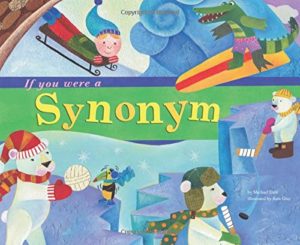 |
Michael Dahl’s If You Were a Synonym (Picture Window Books, 2007) in the Word Fun series is a picture-book explanation of synonyms. (“If you were a synonym…you could be COOL, CHILLY, FROSTY, ICY, WINTRY, or FREEZING. No matter how you say it, you would still be COLD.”) For ages 6-9. In the same series, see Nancy Loewen’s If You Were an Antonym. |
 |
Brian P. Cleary’s Pitch and Throw, Grasp and Know: What Is a Synonym? (Millbrook Press, 2007) is a lively rhyming explanation with many examples and colorful cartoon illustrations. For ages 6-10. Also by Cleary in the same format, see Stop and Go, Yes and No: What Is an Antonym? |
 |
Susan Hood’s Double Take! (Candlewick, 2017) is a new twist on opposites, as a boy and a blue elephant discover that sometimes opposites like big and small or strong and weak are a matter of perspective. For ages 4-8. |
 |
Richard Wilbur’s Opposites, More Opposites, and a Few Differences (Harcourt, 2000) is an illustrated collection of brilliantly clever poems about opposites. (“What’s the opposite of riot?/It’s lots of people keeping quiet.”) A gem for ages 9 and up. |
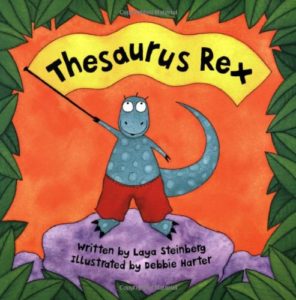 |
Laya Steinberg’s Thesaurus Rex (Barefoot Books, 2005) is a rhyming exploration of synonyms, along with an adorable dinosaur in red trousers. For ages 4-7. |
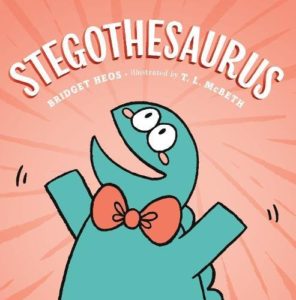 |
In Bridget Heos’s Stegothesaurus (Henry Holt, 2018), the stegothesaurus (blue and wearing a bow tie) is very different from his stegosaurus brothers – he talks in multiple synonyms. For ages 4-8. |
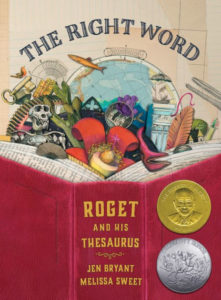 |
By Jen Bryant with wonderful illustrations by Melissa Sweet, The Right Word (Eerdmans Books, 2014) is a picture-book biography of Peter Mark Roget, who published his famous Thesaurus – a treasure trove of synonyms – in 1852. For ages 6-10. Perfect for January 18 which is both Roget’s birthday and National Thesaurus Day. |
 |
The Children’s Illustrated Thesaurus (DK, 2017) is an attractively designed, dictionary-style, 250+-page thesaurus for ages 9-12. |
 |
There are dozens of available thesauruses – but my favorite is the Oxford American Writer’s Thesaurus (Oxford University Press, 2012), an enormous 300,000-word collection of synonyms (and antonyms), helpfully arranged in alphabetical order and interspersed with mini-essays by the highly literate contributing editors. |
DICTIONARIES
 |
In Judy Sierra’s The Great Dictionary Caper (Simon & Schuster, 2018), the dictionary words leave their book and head for Lexi-Con in Hollywood – a wild event featuring a parade with an onomatopoeia marching band, a lot of excited action verbs, and the world’s favorite 32-letter word. There are gatherings of rhyming words (and protests from non-rhyming words), homophones, anagrams, and a palindrome family reunion. Eventually Noah Webster manages to persuade the words to return to their proper places in the dictionary. For ages 4-8. |
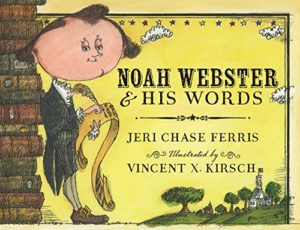 |
By Jeri Chase Ferris, Noah Webster and His Words (Clarion, 2015) is a delightful picture-book story of Noah Webster, author of Webster’s American Dictionary. For ages 6-9. |
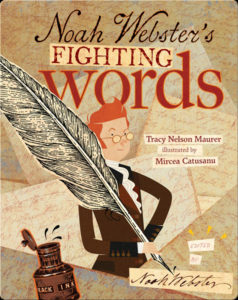 |
Tracy Nelson Maurer’s Noah Webster’s Fighting Words (Millbrook Press, 2017) is a picture-book biography of the author of America’s first dictionary (with comments in the margins by Webster himself). For ages 7-11. |
 |
By lexicographer Jane Solomon, the cleverly designed and illustrated Dictionary of Difficult Words (Frances Lincoln Children’s Books, 2019) is a challenging collection of 400 not-just-ordinary words. Absquatulate? Funambulist? Zenography? (How about a vocabulary bee?) For ages 7-12. |
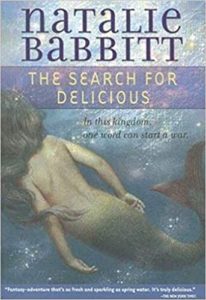 |
In Natalie Babbitt’s The Search for Delicious (Square Fish, 2007), no one can agree on the proper definition for delicious for the realm’s new dictionary – the Prime Minister claims that “Delicious is fried fish;” the General of the Armies says it’s a mug of beer; the Queen, Christmas pudding; and the King, an apple – so twelve-year-old Gaylen is sent off to take a poll of the kingdom. A wonderful story involving a woldweller, a mermaid, a threatening war, and – ultimately – the perfect definition for delicious. For ages 8-12. |
 |
Simon Winchester’s The Meaning of Everything (Oxford University Press, 2018) is the story of the making of the Oxford English Dictionary, a Herculean task, involving many colorful characters. (Learn about J.R.R. Tolkien’s struggle to define “walrus.”) For teens and adults. |
 |
Simon Winchester’s The Professor and the Madman (Harper Perennial, 2005) is the story of the making of the Oxford English Dictionary, which involved as astounding collaboration between British professor James Murray and Dr. William Minor, a Civil War veteran and inmate of Broadmoor, a prison for the criminally insane. For teens and adults. |
 |
The movie version of the book (2019) stars Mel Gibson as James Murray and Sean Penn as Dr. Minor. Ratings show that audiences liked it better than the critics did. For ages 13 and up. |
 |
Lexicographer Kory Stamper’s Word by Word (Vintage, 2018) is a fascinating account of the process of dictionary writing – including the constant struggles over what to define and how to do it and the difficulties of coping with the ever-changing English language – along countless fun facts and anecdotes. For teens and adults. |
